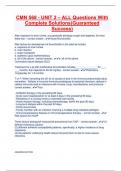CMN 568 - UNIT 2 – ALL Questions With
Complete Solutions(Guaranteed
Success)
After exposure to toxic fumes, a pt gradually develops cough and dyspnea, he most
likely has: - correct answer...✔✔Acute Bronchiolitis
Risk factors for development of bronchiolitis in the adult pt include:
a. exposure to toxic fumes
b. viral infection
c. organ transplant
d. systemic lupus erythematosus
e. all of the above - correct answer...✔✔e. all of the above
Connective tissue disease (SLE)
Treatment for a pt with proliferative bronchiolitis includes________________ for ___-
___ months, then tapered to 20-40 mg/day - correct answer...✔✔Prednisone
1mg/kg/day for 1-3 months
T or F: When narrowing the dif. dx of causes of pna in the immunocompromised adult,
remember - Defects in humoral immunity predispose to bacterial infections; defects in
cellular immunity lead to infections with viruses, fungi, mycobacteria, and protozoa. -
correct answer...✔✔True
- Antibiotic therapy in the preceding 90 days.
- Acute care hospitalization for at least 2 days in the preceding 90 days.
- Residence in a nursing home or extended care facility.
- Home infusion therapy, including chemotherapy, within the past 30 days.
- Long-term dialysis within the past 30 days.
- Home wound care.
- Family member with an infection involving a multiple drug-resistant pathogen.
- Immunosuppressive disease or immunosuppressive therapy. - correct answer...✔✔
Risk factors for HCAP
Three factors distinguish nosocomial pneumonia from CAP: - correct answer...✔✔(1)
different infectious causes.
(2) different antibiotic susceptibility patterns, specifically, a higher incidence of drug
resistance.
(3) the patients' underlying health status that puts them at risk for more severe
infections.
AGRADESOLUTIONS
,Colonization of the ________ and possibly the ________ with bacteria is the most
important step in the pathogenesis of nosocomial pneumonia. - correct answer...✔✔
pharynx; stomach
Within ___ hours of admission, ___% of seriously ill hospitalized patients have their
upper airway colonized with organisms from the hospital environment. - correct
answer...✔✔48; 75%
Patients with anaerobic pleuropulmonary infection usually present with constitutional
symptoms such as fever, weight loss, and malaise, dentition is often poor, however,
rarely edentulous; if so, an
________ ________ ________is usually present. - correct answer...✔✔obstructing
bronchial lesion
Representative material for culture of anaerobic organisms can be obtained only by
a. transthoracic aspiration
b. thoracentesis
c. bronchoscopy with a protected brush.
d. all of the above - correct answer...✔✔d. all of the above
Expectoration is inappropriate.
This anaerobic pleuropulmonary infection appears as a thick-walled solitary cavity
surrounded by consolidation.
a. Empyema
b. Necrotizing pna
c. Lung abscess
d. A and C - correct answer...✔✔c. Lung abscess
T or F: Refer all pts with CXR findings consistent with anaerobic pleuropulmonary
infection for hospital admission, IV abx, and most likely a chest tube. - correct answer...
✔✔True
____________ alone is inadequate treatment for anaerobic pleuropulmonary infections
because an increasing number of anaerobic organisms produce B-lactamases - correct
answer...✔✔PCN
Neutropenia and impaired granulocyte function predispose to infections from S aureus,
Aspergillus, gram-negative bacilli, and Candida. - correct answer...✔✔...
Knowledge of the underlying immunologic defect and the time course of infection
provides clues to the etiology of pneumonia in immunocompromised patients. - correct
answer...✔✔...
AGRADESOLUTIONS
, In the immunocompromised patient a __________ pneumonia is often caused by
bacterial infection, whereas an _________ pneumonia is more apt to be caused by viral,
fungal, protozoal, or mycobacterial infection. - correct answer...✔✔Fulminant; insidious
Pneumonia occurring within 2-4 weeks after organ transplantation is usually
__________, whereas several months or more after transplantation P jiroveci,
__________and _______ are encountered more often. - correct answer...✔✔Bacterial;
viruses; fungi
Substances with potential to embolize to the pulmonary circulation - correct answer...✔
✔air, amniotic fluid, fat, foreign bodies, parasite eggs (schistosomiasis), septic emboli,
tumor cells, thrombus (most commond)
Risk factors for PE and DVT - correct answer...✔✔Venous stasis, injury to the vessel
wall, and hypercoagulability -- VIRCHOW TRIAD
Causes of venous stasis... - correct answer...✔✔Immobility, hyperviscosity
(polycythemia), increased CVP (low CO, pregnancy)
Causes of hypercoagulability... - correct answer...✔✔Oral contraceptives, HRT,
malignancy/surgery, inherited gene defects (Factor V Leiden)
Massive pulmonary thrombus may cause... - correct answer...✔✔Right Ventricular
Failure
T or F: Common S/S of PE are specific to the disorder. - correct answer...✔✔False
3 S/S seen in most pts presenting with PE... - correct answer...✔✔Dyspnea, CP with
breathing, tachypnea.
2 Common ECG changes with PE: - correct answer...✔✔ST and nonspecific ST & T
wave changes.
Profound_______ with a normal_____in the absence of preexisting lung disease is
highly suspicious for PE. - correct answer...✔✔Hypoxia, CXR
A D-Dimer < __________ provides strong evidence against PE. - correct answer...✔✔
500 ng/ml
Initial diagnostic study used for suspected PE: - correct answer...✔✔Helical CT
pulmonary angiography
Radiolabeled microaggregated albumin is injected into the venous system, allowing the
particles to embolize to the pulmonary capillary bed. - correct answer...✔✔Perfusion
Scan
AGRADESOLUTIONS




